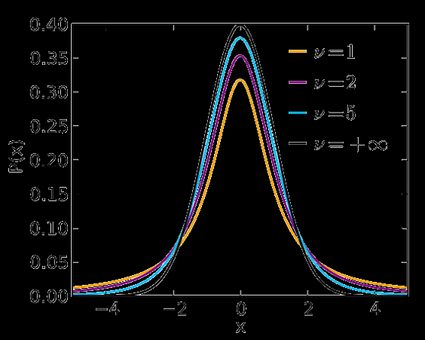how to find critical value on statcrunch
Welcome to the critical value calculator! Here y'all can rapidly determine the critical value(s) for two-tailed tests, also every bit for 1-tailed tests. It works for most common distributions in statistical testing: the standard normal distribution Due north(0,1) (that is, when you lot take a Z-score), t-Student, chi-foursquare, and F-distribution.
What is a critical value? And what is the critical value formula? Scroll downwardly - we provide you lot with the disquisitional value definition and explicate how to calculate critical values in order to use them to construct rejection regions (as well known as critical regions).
What is a critical value?
In hypothesis testing, critical values are one of the two approaches which permit yous to determine whether to retain or reject the zero hypothesis. The other approach is to calculate the p-value.
The critical value approach consists of checking if the value of the examination statistic generated by your sample belongs to the and then-called rejection region, or critical region, which is the region where the exam statistic is highly improbable to lie. A critical value is a cut-off value (or two cut-off values in case of a 2-tailed exam) that constitutes the boundary of the rejection region(s). In other words, disquisitional values carve up the scale of your test statistic into the rejection region and non-rejection region.
In one case you have found the rejection region, bank check if the value of test statistic generated by your sample belongs to it:
- if and so, it means that you can reject the aught hypothesis and have the alternative hypothesis; and
- if not, then there is not enough evidence to reject H₀.
Just, how to summate disquisitional values? First of all, you need to set a significance level, α, which quantifies the probability of rejecting the nada hypothesis when it is actually correct. The pick of α is arbitrary; in practice, nosotros nigh often utilize a value of 0.05 or 0.01. Disquisitional values depend also on the culling hypothesis you choose for your exam, elucidated in the .
Critical value definition
To determine critical values, you demand to know the distribution of your exam statistic under the assumption that the nothing hypothesis holds. Critical values are then the points on the distribution which have the same probability as your test statistic, equal to the significance level α. These values are assumed to exist at least as extreme at those critical values.
The alternative hypothesis determines what "at to the lowest degree as farthermost" means. In detail, if the test is one-sided, then there will be just 1 disquisitional value, if information technology is ii-sided, then there will exist two of them: one to the left and the other to the right of the median value of the distribution.
Disquisitional values can be conveniently depicted as the points with the property that the area nether the density curve of the test statistic from those points to the tails is equal to α:
-
left-tailed test: the area under the density curve from the critical value to the left is equal to
α; -
right-tailed test: the area nether the density bend from the critical value to the right is equal to
α; and -
two-tailed test: the expanse under the density curve from the left critical value to the left is equal to
α/2and the expanse under the bend from the right disquisitional value to the right is equal toα/iilikewise; thus, total area equalsα.

Equally you tin see, finding the critical values for a 2-tailed examination with significance α boils downward to finding both 1-tailed critical values with a significance level of α/2.
How to summate disquisitional values?
The formulae for the disquisitional values involve the quantile function, Q , which is the inverse of the cumulative distribution function (cdf) for the test statistic distribution (calculated under the supposition that H₀ holds!): Q = cdf-ane
Once we take agreed upon the value of α, the critical value formulae are the following:
-
left-tailed test:
(-∞, Q(α)] -
right-tailed examination:
[Q(1 - α), ∞) -
ii-tailed test:
(-∞, Q(α/ii)] ∪ [Q(1 - α/2), ∞)
In the instance of a distribution symmetric almost 0, the critical values for the ii-tailed test are symmetric likewise:
Q(one - α/ii) = -Q(α/2)
Unfortunately, the probability distributions that are the almost widespread in hypothesis testing take a somewhat complicated cdf formulae. To discover disquisitional values by hand, yous would demand to use specialized software or statistical tables. In these cases, the best choice is, of form, our critical value reckoner! 😁
How to use this critical value figurer?
Now that you take found our critical value estimator, you no longer need to worry how to find critical value for all those complicated distributions! Hither are the steps you need to follow:
-
Tell u.s.a. the distribution of your exam statistic under the null hypothesis: is it a standard normal N(0,one), t-Student, chi-squared, or Snedecor's F? If you are non sure, check the sections beneath devoted to those distributions, and try to localize the test yous demand to perform.
-
Choose the culling hypothesis: two-tailed, right-tailed, or left-tailed.
-
If needed, specify the degrees of freedom of the test statistic'southward distribution. If y'all are not certain, check the description of the exam you are performing.
-
Set the significance level,
α. Nosotros pre-gear up it to the near common value, 0.05, past default, simply y'all tin, of course, arrange it to your needs. -
The critical value estimator will then display not but your critical value(south) merely too the rejection region(s).
Go to the avant-garde manner of the critical value calculator if you need to increase the precision with which the critical values are computed.
Z disquisitional values
Use the Z (standard normal) option if your examination statistic follows (at least approximately) the standard normal distribution N(0,1).
StefanPohl / CC0 wikimedia.org
In the formulae beneath, u denotes the quantile function of the standard normal distribution N(0,ane):
-
left-tailed Z critical value:
u(α) -
right-tailed Z critical value:
u(ane - α) -
two-tailed Z critical value:
±u(ane - α/2)
Check out Z-test calculator to learn more virtually the nigh common Z-test used on the population mean. There are also Z-tests for the divergence betwixt two population ways, in detail one between 2 proportions.
t critical values
Use the t-Student selection if your test statistic follows the t-Student distribution. This distribution is similar to Due north(0,one), merely its tails are fatter - the exact shape depends on the number of degrees of liberty. If this number is large (>thirty), which generically happens for large samples, then the t-Educatee distribution is practically duplicate from Northward(0,1). Cheque our t-statistic calculator to compute the related test statistic.

Skbkekas / CC BY wikimedia.org
In the formulae below, Qt,d is the quantile function of the t-Student distribution with d degrees of freedom:
-
left-tailed t critical value:
Qt,d(α) -
right-tailed t critical value:
Qt,d(1 - α) -
two-tailed t critical values:
±Qt,d(1 - α/two)
Visit the t-test calculator to acquire more well-nigh diverse t-tests: the one for a population mean with an unknown population standard deviation, those for the difference between the means of two populations (with either equal or unequal population standard deviations), too as about the t-examination for paired samples.
chi-square critical values (χ²)
Use the χ² (chi-foursquare) option when performing a test in which the test statistic follows the χ²-distribution.
You lot need to make up one's mind the number of degrees of freedom of the χ²-distribution of your test statistic - beneath we list them for the most commonly used χ²-tests.
Geek3 / CC Past wikimedia.org
Here we give the formulae for chi square critical values; Qχ²,d is the quantile office of the χ²-distribution with d degrees of liberty:
-
Left-tailed χ² disquisitional value:
Qχ²,d(α) -
Right-tailed χ² critical value:
Qχ²,d(i - α) -
2-tailed χ² critical values:
Qχ²,d(α/2)andQχ²,d(one - α/2)
Several different tests lead to a χ²-score:
-
Goodness-of-fit test: does the empirical distribution agree with the expected distribution?
This test is right-tailed. Its test statistic follows the χ²-distribution with
g - 1degrees of freedom, wheregrandis the number of classes into which the sample is divided. -
Independence test: is there a statistically significant relationship between two variables?
This test is as well right-tailed, and its exam statistic is computed from the contingency table. There are
(r - one)(c - 1)degrees of freedom, whereris the number of rows, andcthe number of columns in the contingency table. -
Test for the variance of ordinarily distributed information: does this variance have some pre-determined value?
This test can be 1- or two-tailed! Its test statistic has the χ²-distribution with
northward - 1degrees of freedom, wheredue northis the sample size.
F critical values
Finally, choose F (Fisher-Snedecor) if your test statistic follows the F-distribution. This distribution has a pair of degrees of freedom.
Allow us see how those degrees of freedom ascend. Assume that you have two independent random variables, X and Y, that follow χ²-distributions with d1 and d2 degrees of freedom, respectively. If you lot now consider the ratio (10/done)/(Y/dtwo), it turns out it follows the F-distribution with (d1, d2) degrees of freedom. That'south the reason why nosotros telephone call done and d2 the numerator and denominator degrees of freedom, respectively.
IkamusumeFan / CC By-SA wikimedia.org
In the formulae below, QF,d1,dtwo stands for the quantile office of the F-distribution with (d1, dtwo)degrees of freedom:
-
Left-tailed F disquisitional value:
QF,d1,d2 (α) -
Correct-tailed F critical value:
QF,d1,dii (one - α) -
Two-tailed F disquisitional values:
QF,d1,d2 (α/2)andQF,d1,dii (1 - α/2)
Here nosotros list the well-nigh important tests that produce F-scores: each of them is right-tailed.
-
ANOVA: tests the equality of ways in iii or more groups that come from normally distributed populations with equal variances. In that location are
(1000 - 1, due north - chiliad)degrees of freedom, wheremis the number of groups, andnis the total sample size (across every group). -
Overall significance in regression analysis. The test statistic has
(k - i, north - chiliad)degrees of liberty, wherenis the sample size, andkis the number of variables (including the intercept). -
Compare two nested regression models. The examination statistic follows the F-distribution with
(one thousand2 - ki, n - chiliad2)degrees of freedom, wherek1andk2are the number of variables in the smaller and bigger models, respectively, andnis the sample size. -
The equality of variances in two normally distributed populations. At that place are
(due north - 1, 1000 - 1)degrees of freedom, wherenandmare the respective sample sizes.
Source: https://www.omnicalculator.com/statistics/critical-value
Posted by: novakdartakifinee.blogspot.com

0 Response to "how to find critical value on statcrunch"
Post a Comment